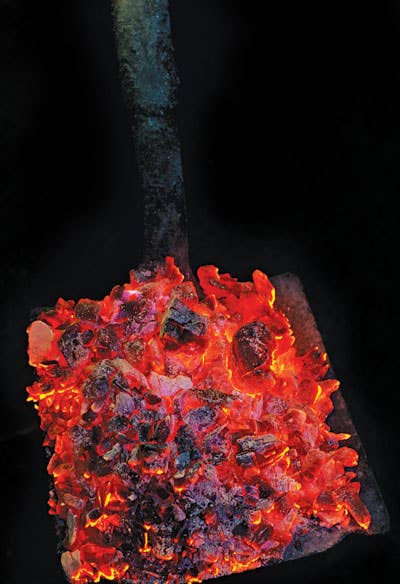
Fuel and Flavor
Successful barbecue relies largely on controlling two variables: heat and smoke.
Successful barbecue relies largely on controlling two variables: heat and smoke. Choosing a fuel that can burn for hours at a low, steady temperature, as well as the right wood to impart that signature smoky flavor, is essential.
Maintaining a low, even temperature is key for transforming tough cuts into tender barbecue, and for that, charcoal is the ideal fuel. It burns steadily and cleanly, which is imperative for barbecue's long smoke times. Charcoal comes in two forms: Lump charcoal—wood that's been burned in the absence of oxygen, which reduces it to almost pure carbon—has the advantage of being free of chemical additives and binders. But because it's made from wood only, it has wood's irregularities—it comes in different sizes and densities, which can make keeping a steady temperature challenging in vessels where airflow cannot be controlled, such as a kettle grill, as some pieces will burn faster than others. But for cookers like the Primo Oval, where it's possible to regulate air intake, lump charcoal will provide a steady burn. Charcoal briquettes, made from charcoal combined with binding elements and ignition aids and formed into bricks, are the most widely available barbecue fuel; their uniform shape, size, and density make them great for cooking in kettle grills. You can also get natural briquettes, which contain only charcoal and a natural binder. These combine the best qualities of lump charcoal and briquettes: clean-burning, even heat. (Avoid briquettes that have been impregnated with lighter fluid, as they'll impart a chemical flavor to meat.)
While charcoal provides the low heat required for slow-cooking meat, wood, added in chunks or chips to a bed of coals, accounts for the smoky flavor. The best ones for barbecuing are hardwoods: close-grained, low-resin woods that burn slowly and give off aromatic smoke. Different varieties bring distinct flavors to meat. The two most widely used woods in the United States, hickory and oak, emit medium to strong smoke and are a good match for a wide range of meats. The smoke of milder woods, like alder (used to smoke salmon) and maple (ideal for pork), provide a soft, sweet flavor. Fruitwoods like cherry and apple are more assertive, with a fruity fragrance that enhances poultry and pork. Post oak is found almost exclusively in Texas, where its subtle smoke is a hallmark of Hill Country barbecue. Mesquite, common throughout the Southwest, is a highly resinous wood, and its smoke has a sweet perfume.
All of these woods come in forms suited to different kinds of cookers. Wood shavings (sold under the brand name Camerons Smoking Chips) are the best choice forthe Camerons Stovetop Smoker, as they burn quickly. Wood chips, roughly two inches in size, work well in gas grills, where you want a wood that smolders longer than shavings but doesn't take long to ignite. Larger and denser wood chunks (about fist size) are the best choice for the widest range of applications; they're slower burning, won't require replenishing over the course of long cooking, and allow you to control the level of smoke by removing or adding chunks. Use wood that's been dried for at least three months after cutting; if the wood is fresh-cut, the smoke will be sooty and impart a bitter taste to the meat. To ensure a slow burn, soak wood overnight in water before using so that it smolders when it hits the coals (if you add it dry, the wood will catch Are and burn out of control).
Keep Reading
Continue to Next Story










